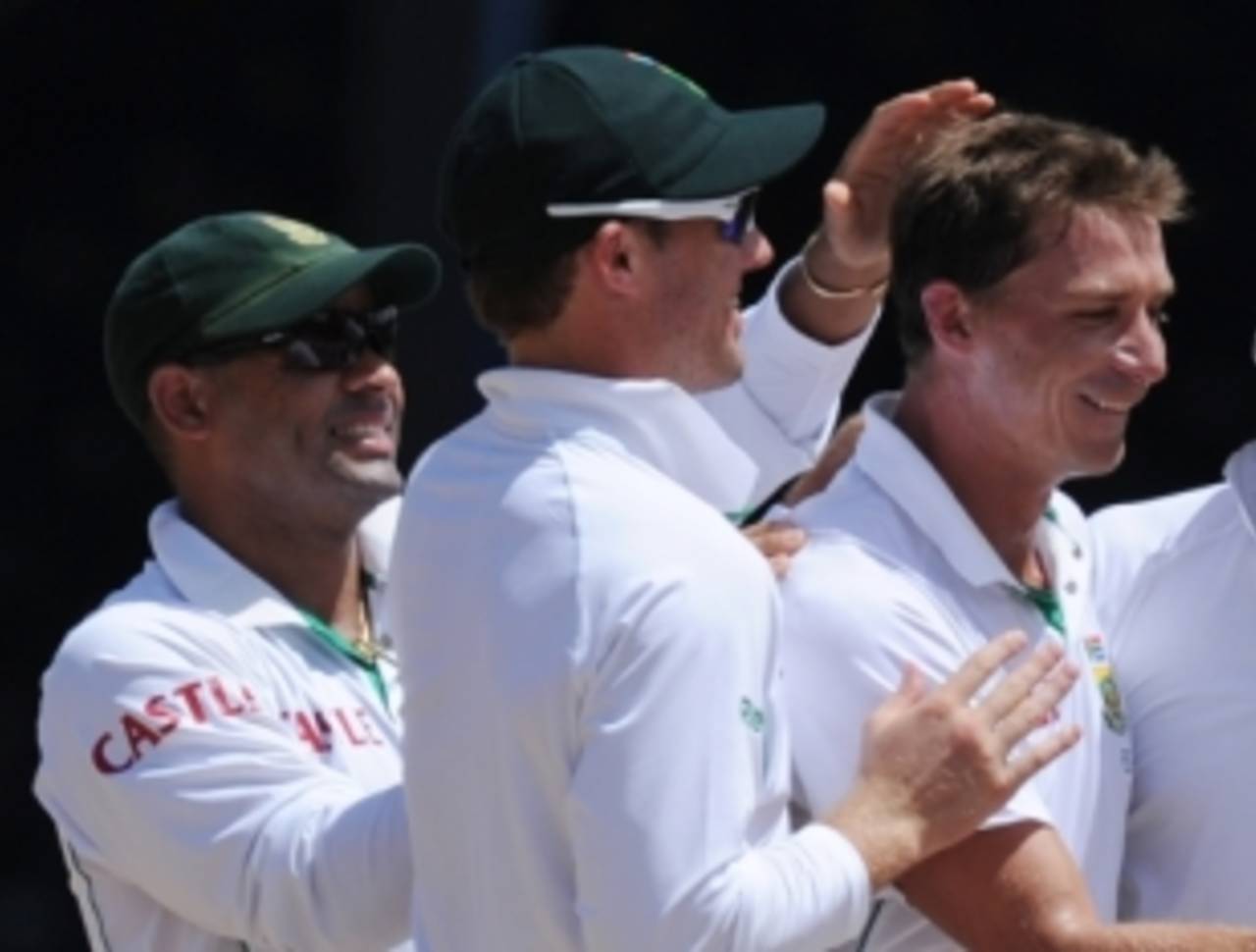Sweat-stained hanky? Me, me
In which the future of sports memorabilia is revealed
Sue de Groot
29-Jul-2010

Steyn's team-mates surreptitiously pull hairs out of his head for future use while pretending to celebrate a wicket • AFP
So in a recent-ish issue of the Spectator - a publication named for and aimed squarely at cricket watchers - there is a page advertising "Cricket Books, Letters and Memorabilia from the archives of Glamorgan CCC".
Glamorgan CCC must have fallen on hard times, otherwise why would it be selling such treasures as a Wisden Cricketers'Almanack from 1866 (which appears from the picture to have a detached spine, but nevertheless is estimated to go under the hammer at £3000) and a signed photograph of Sir Jack Hobbs, dated 1925 and priced at a paltry £300?
There's also a set of three knobbly pieces of wood claiming to be late-19th-century stumps, all nicely polished and mounted in a glass-fronted case, but still looking like someone hacked them off the nearest mulberry bush with no thought for consistency of girth. Which probably means that they are, in fact, authentic 19th-century stumps.
I hope Glamorgan makes some money out of this, with which to buy new blades for their lawnmower, or to replace their chipped teacups, or to do whatever it is that has forced them into such a cash-flow crisis. No doubt there will be enthusiasts flocking to bid for the autographed postcards and telegrams and such, but the second question I want to ask is: why? Why do people want sporting items once touched by the greats? Someone I know knows someone else who bought Michael Schumacher's shell suit and now parks his car out in the rain so that he can display the suit in his garage, with lots of space for visitors to walk around it and admire the seamsmanship from all sides.
There's something about sporting memorabilia that makes previously sane people lose their minds and their savings. Maybe wearing a cap that once cooled the brow of Donald Bradman confers a corollary glory onto the new owner; maybe it causes motorists passing his house to slow in awe and point at him as he nonchalantly trims his hedges. Maybe hanging Garry Sobers' tie above your bar makes your mates think more of you as they down their complimentary tequilas. I don't know.
Maybe I'm an insensitive cretin, but I fail to see the logic in giving up a holiday in Mallorca for the sake of displaying Shane Warne's box in the conservatory
Maybe I'm an insensitive cretin, but I fail to see the logic in giving up a holiday in Mallorca for the sake of displaying Shane Warne's box in the conservatory. I suppose, given the number of people who attach value to discarded celebrity appurtenances, you could sell it for a profit one day, but collectors of such things, so I'm told, would rather sell a vital organ to pay the gas bill than let go of that coveted white coat with Dickie Bird's sweat stains still on it.
There is a market here, ripe for exploitation by the cads among us. If I'd been in the West Indies last month, at the match that caused all the trouble, I'd have been first on the pitch with one of those wooden tongue depressors purloined from my dentist's surgery, on my knees, carefully scraping Dale Steyn's precious sputum from the grass and saving it in a test tube for posterity and profit. What would that go for, I wonder? I imagine the collectors would be beating at my door with fistfuls of cash, desperate to impress their dinner-party guests with a centrepiece of phlegmatic grandeur. And if your guests complained about the slow service you could always pour a little Steyn spit into their food.
Has anyone bothered to pick up the myriad wads of chewed gum discarded by Graeme Smith? I bet they have, and I bet one day we'll see those bits of masticated rubber mounted in glass cases on eBay, complete with DNA-verification certificates to prove their provenance.
The difference between these modern-day auctioneer's dreams and the crooked stumps advertised in the Spectator is that at least bodily fluids can be put to some use. When the superstitiously inclined learn to accept the inevitability of human cloning, and experimental scientists emerge from their basements and into the commercial light of day, the demand for celebrity forensic matter will be immense. Mark my words, the person wise enough to have secreted a piece of bloodstained Elastoplast that came off Jonty Rhodes's thumb after a landmark catch will one day be able to retire in splendour to a shuttered chateau. Because instead of grubby memorabilia cluttering the garage, there will be hordes of small, cloned Dales and Biffs and Jontys clutching the bars of their laboratory playpens while international sporting agents bid wildly for their purchase. Now there's an investment.
Sue de Groot is a Johannesburg-based journalist, columnist and television scriptwriter